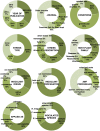Arbuscular Mycorrhizal Fungi as Natural Biofertilizers: Let's Benefit from Past Successes
- PMID: 26834714
- PMCID: PMC4717633
- DOI: 10.3389/fmicb.2015.01559
Arbuscular Mycorrhizal Fungi as Natural Biofertilizers: Let's Benefit from Past Successes
Abstract
Arbuscular Mycorrhizal Fungi (AMF) constitute a group of root obligate biotrophs that exchange mutual benefits with about 80% of plants. They are considered natural biofertilizers, since they provide the host with water, nutrients, and pathogen protection, in exchange for photosynthetic products. Thus, AMF are primary biotic soil components which, when missing or impoverished, can lead to a less efficient ecosystem functioning. The process of re-establishing the natural level of AMF richness can represent a valid alternative to conventional fertilization practices, with a view to sustainable agriculture. The main strategy that can be adopted to achieve this goal is the direct re-introduction of AMF propagules (inoculum) into a target soil. Originally, AMF were described to generally lack host- and niche-specificity, and therefore suggested as agriculturally suitable for a wide range of plants and environmental conditions. Unfortunately, the assumptions that have been made and the results that have been obtained so far are often worlds apart. The problem is that success is unpredictable since different plant species vary their response to the same AMF species mix. Many factors can affect the success of inoculation and AMF persistence in soil, including species compatibility with the target environment, the degree of spatial competition with other soil organisms in the target niche and the timing of inoculation. Thus, it is preferable to take these factors into account when "tuning" an inoculum to a target environment in order to avoid failure of the inoculation process. Genomics and transcriptomics have led to a giant step forward in the research field of AMF, with consequent major advances in the current knowledge on the processes involved in their interaction with the host-plant and other soil organisms. The history of AMF applications in controlled and open-field conditions is now long. A review of biofertilization experiments, based on the use of AMF, has here been proposed, focusing on a few important factors that could increase the odds or jeopardize the success of the inoculation process.
Keywords: abiotic and biotic stress; arbuscular mycorrhizal fungi (AMF); inoculation; plant nutrition; transcriptomics.
Figures


Similar articles
-
Role of Arbuscular Mycorrhizal Fungi in Regulating Growth, Enhancing Productivity, and Potentially Influencing Ecosystems under Abiotic and Biotic Stresses.Plants (Basel). 2023 Aug 29;12(17):3102. doi: 10.3390/plants12173102. Plants (Basel). 2023. PMID: 37687353 Free PMC article. Review.
-
Biofertilizers and sustainable agriculture: exploring arbuscular mycorrhizal fungi.Appl Microbiol Biotechnol. 2017 Jun;101(12):4871-4881. doi: 10.1007/s00253-017-8344-z. Epub 2017 May 25. Appl Microbiol Biotechnol. 2017. PMID: 28547568 Review.
-
Can arbuscular mycorrhizal fungi and rhizobacteria facilitate 33P uptake in maize plants under water stress?Microbiol Res. 2023 Jun;271:127350. doi: 10.1016/j.micres.2023.127350. Epub 2023 Mar 5. Microbiol Res. 2023. PMID: 36913786
-
Effects of arbuscular mycorrhizal fungi on plant growth and herbivore infestation depend on availability of soil water and nutrients.Front Plant Sci. 2023 Jan 26;14:1101932. doi: 10.3389/fpls.2023.1101932. eCollection 2023. Front Plant Sci. 2023. PMID: 36778709 Free PMC article.
-
Establishment and effectiveness of inoculated arbuscular mycorrhizal fungi in agricultural soils.Plant Cell Environ. 2016 Jan;39(1):136-46. doi: 10.1111/pce.12600. Epub 2015 Oct 27. Plant Cell Environ. 2016. PMID: 26147222
Cited by
-
Comprehensive Assessment of Ameliorative Effects of AMF in Alleviating Abiotic Stress in Tomato Plants.J Fungi (Basel). 2021 Apr 15;7(4):303. doi: 10.3390/jof7040303. J Fungi (Basel). 2021. PMID: 33921098 Free PMC article. Review.
-
Great gerbil burrowing-induced microbial diversity shapes the rhizosphere soil microenvironments of Haloxylon ammodendron in temperate deserts.Front Microbiol. 2022 Aug 10;13:960594. doi: 10.3389/fmicb.2022.960594. eCollection 2022. Front Microbiol. 2022. PMID: 36051766 Free PMC article.
-
The Belowground-Aboveground Interactions of Zucchini: The Effects of Trichoderma afroharzianum Strain T22 on the Population and Behavior of the Aphid Aphis gossypii Glover and Its Endoparasitoid Aphidius colemani Viereck.Insects. 2024 Sep 12;15(9):690. doi: 10.3390/insects15090690. Insects. 2024. PMID: 39336658 Free PMC article.
-
Legacy Effects of Biochar and Compost Addition on Arbuscular Mycorrhizal Fungal Community and Co-Occurrence Network in Black Soil.Microorganisms. 2022 Oct 28;10(11):2137. doi: 10.3390/microorganisms10112137. Microorganisms. 2022. PMID: 36363729 Free PMC article.
-
Cover Crops Modulate the Response of Arbuscular Mycorrhizal Fungi to Water Supply: A Field Study in Corn.Plants (Basel). 2023 Feb 23;12(5):1015. doi: 10.3390/plants12051015. Plants (Basel). 2023. PMID: 36903877 Free PMC article.
References
-
- Affokpon A., Coyne D. L., Lawouin L., Tossou C., Agbèdè R. D., Coosemans J. (2011). Effectiveness of native West African arbuscular mycorrhizal fungi in protecting vegetable crops against root-knot nematodes. Biol. Fertil. Soils 47, 207–217. 10.1007/s00374-010-0525-1 - DOI
-
- Allen M. F. (1987). Ecology of vesicular-arbuscular mycorrhizae in an arid ecosystem: use of natural processes promoting dispersal and establishment, Mycorrhizae Decade Practical Applications and Research Priorities 7th NACOM IFAS (Gainesville, FL: ), 133–135.
-
- Allen M. F. (2011). Linking water and nutrients through the vadose zone: a fungal interface between the soil and plant systems: linking water and nutrients through the vadose zone: a fungal interface between the soil and plant systems. J. Arid Land 3, 155–163. 10.3724/SP.J.1227.2011.00155 - DOI
Publication types
LinkOut - more resources
Full Text Sources
Other Literature Sources
Miscellaneous

